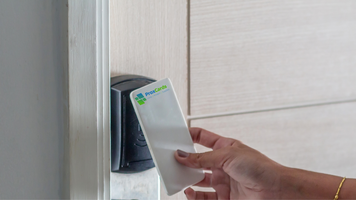What to Do If Your Prox Card Isn’t Working: Troubleshooting Tips and Common Causes
13th May 2025
Proximity cards—commonly known as prox cards—are a trusted tool for secure, contactless access control. They're widely used in office buildings, schools, hospitals, and many other facilities. But what happens when your prox card suddenly stops working? Whether you're locked out or facing daily inconsistencies, it's frustrating—and potentially disruptive—to deal with a malfunctioning credential.
In this blog, we’ll walk you through what to check, why prox cards might fail, and what steps you can take to restore access quickly and securely.
Common Reasons Why Prox Cards Fail
Before jumping to replacement, it helps to understand what might be causing the problem. Here are the most common culprits:
1. Card Damage- Prox cards contain a small embedded antenna and chip. If the card is bent, cracked, or physically worn out, the internal components may be damaged. Exposure to extreme heat or moisture can also degrade functionality.
2. Reader Issues- Sometimes it’s not the card—it’s the reader. A dirty or malfunctioning reader can prevent successful communication. Try using your card at another access point to determine whether the issue is isolated to a specific reader.
3. Deactivation- Your card may have been deactivated, either manually by an administrator or automatically due to a system update, security change, or expired access.
4. Interference from Other Items- Carrying multiple cards, RFID-enabled items, or metal objects next to your badge can interfere with the card reader’s ability to scan properly. Try presenting just your prox card by itself.
5. Wrong Format or Encoding- In some cases, cards may be incorrectly encoded or programmed with a format that your system doesn’t recognize—especially if the card was recently issued or replaced.
Troubleshooting Steps
If your card isn’t working, follow these steps to determine the cause:
1. Inspect the Card- Look for visible wear, cracks, or warping. If the card looks damaged, it’s likely time for a replacement.
2. Clean the Reader- Use a soft, lint-free cloth to clean around the reader area. Dust and debris can interfere with signal transmission.
3. Test at Another Door- Try accessing another door or area in the facility. If the card works there, the original reader may be faulty or offline.
4. Remove Potential Interference- Take the card out of your wallet or badge holder and present it directly to the reader. Remove any other RFID items nearby.
5. Contact Your Administrator- Ask your building or IT admin to check your card status in the system. They can verify if your card is active, review your access permissions, and reprogram the card if needed.
When to Replace Your Prox Card
If your card is damaged, lost, or no longer reading consistently despite troubleshooting, replacement is the best option. Fortunately, most organizations can reissue a new prox card quickly. Make sure your new card is correctly encoded and tested before leaving the issuance office.
Preventive Tips to Avoid Card Failures
- Store your card properly – Avoid putting it in tight pockets or near magnets or metal.
- Use a badge holder – Protects your card from bending and exposure to moisture.
- Keep it away from direct heat – Prox cards can warp if left in hot cars or next to heat sources.
- Report issues early – If your card starts acting inconsistently, notify your admin before you’re completely locked out.
Still Having Issues? We Can Help.
If your organization is experiencing frequent prox card problems, it might be time to evaluate your access control system. From faulty cards to aging readers or outdated formats, we can help you identify the root cause—and offer smarter, more reliable alternatives like mobile credentials or smart cards.
Need help with prox card troubleshooting or replacements? Contact us today for support and solutions.

